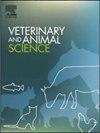Bayesian predictive modelling to ascertain factors affecting cattle milk production in Tanzania: Evidence from the national panel surveys 2012 – 2021
IF 1.9
Q2 AGRICULTURE, DAIRY & ANIMAL SCIENCE
引用次数: 0
Abstract
This study aimed to evaluate and compare Bayesian predictive models to identify and quantify the key household inputs affecting cattle milk production in Tanzania. A sample of 1,266 households with at least one milked cow was extracted from the National Panel Survey datasets, the data were collected in 2012/2013 (wave 3), 2014/2015 (wave 4), and 2020/2021 (wave 5). Two generalized linear and generalized additive mixed models were fitted using the Integrated Nested Laplace Approximation. The fitted models were evaluated by using Root Mean Squared Error (RMSE), Deviance Information Criteria (DIC), and Watanabe Information Criteria (WAIC). The findings indicate that the generalized linear mixed model with a gamma distribution performed best, as it balanced good fit and predictive performance (RMSE=1.47, DIC=5,061.36, and WAIC=5,079.45). Although the generalized additive mixed model with a gamma distribution had a better fit (DIC=5,006.54 and WAIC=5,074.43), it had a higher RMSE (1.89), making it less suitable for prediction. The study identified that household inputs, such as major feeding practices, person-administered tick treatment, and total labour cost significantly affect cattle milk production, as their 95% credible intervals did not include zero. In conclusion, the study provides valuable insights into the relationship between milk production and household inputs while incorporating prior knowledge about the parameters into the analysis and considering mixed effects models. The study's insights into significant household inputs can guide dairy farmers and policymakers in optimising milk production practices by focusing on key variables such as feeding practices, health management, and labour costs.

贝叶斯预测模型确定影响坦桑尼亚牛乳产量的因素:2012-2021 年全国面板调查的证据。
本研究旨在评估和比较贝叶斯预测模型,以确定和量化影响坦桑尼亚牛乳生产的关键家庭投入。从全国面板调查数据集中抽取了至少有一头挤奶牛的 1266 个家庭样本,数据收集时间分别为 2012/2013 年(第 3 次调查)、2014/2015 年(第 4 次调查)和 2020/2021 年(第 5 次调查)。使用综合嵌套拉普拉斯近似法拟合了两个广义线性和广义加性混合模型。利用均方根误差(RMSE)、偏差信息标准(DIC)和渡边信息标准(WAIC)对拟合模型进行了评估。结果表明,伽马分布的广义线性混合模型表现最佳,因为它兼顾了良好的拟合和预测性能(RMSE=1.47,DIC=5,061.36,WAIC=5,079.45)。虽然伽马分布的广义加法混合模型拟合度较好(DIC=5,006.54,WAIC=5,074.43),但其有效值较高(1.89),因此不太适合预测。研究发现,家庭投入(如主要饲养方式、人工蜱治疗和总劳动力成本)对牛的产奶量有显著影响,因为其 95% 可信区间不包括零。总之,这项研究为牛奶产量与家庭投入之间的关系提供了宝贵的见解,同时将有关参数的先验知识纳入分析,并考虑了混合效应模型。该研究对重要家庭投入的见解可指导奶牛场主和政策制定者通过关注饲养方式、健康管理和劳动力成本等关键变量来优化牛奶生产实践。
本文章由计算机程序翻译,如有差异,请以英文原文为准。
求助全文
约1分钟内获得全文
求助全文
来源期刊

Veterinary and Animal Science
Veterinary-Veterinary (all)
CiteScore
3.50
自引率
0.00%
发文量
43
审稿时长
47 days
 求助内容:
求助内容: 应助结果提醒方式:
应助结果提醒方式:


